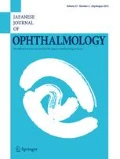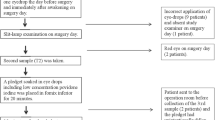Abstract
Purpose
To compare the effect of a reduced concentration (1.25 %) of povidone–iodine (PI) eye drops, combined with 0.5 % topical levofloxacin (LVFX), with that of the standard of care (5 % PI) on conjunctival flora before intravitreal injections (IVT).
Methods
A prospective, randomized, single-blind clinical trial. One hundred eyes from 100 patients who underwent IVT were included. Eyes were randomly assigned to two groups and underwent different preparatory procedures before therapeutic IVT. LVFX drops were instilled three times every 5 min and then either 1.25 % PI drops were instilled three times every few minutes in group A or 5 % PI drops were instilled three times every few minutes in group B, the control. Conjunctival flora and the injection needles were collected for culture both before and after preparation. The number of positive cultures, the species isolated, and the minimum inhibitory concentrations (MIC) of the antibiotics were assessed.
Results
The pretreatment culture was positive for 45 eyes (86.5 %) in group A (n = 52) and for 37 eyes (77.1 %) in group B (n = 48). After the preparatory procedure, the cultures were positive for 25 eyes (48.1 %) in group A and for 27 eyes (56.3 %) in group B (P = 0.43). After preparation, the number of positive cultures decreased by 46.7 % in group A and by 33.4 % in group B (P = 0.48). No needle samples were contaminated in either group. The most common isolate in both groups after preparation for surgery was Propionibacterium acnes. Among the different antibiotics, vancomycin and oxacillin had the lowest MIC >90 for overall isolates.
Conclusions
1.25 % PI with LVFX is as effective as 5 % PI. P. acnes was the most common conjunctival flora detected. Vancomycin has been confirmed as the best choice for treating infectious endophthalmitis after IVT.

Similar content being viewed by others
References
Bressler NM. Antiangiogenic approaches to age-related macular degeneration today. Ophthalmology. 2009;116:S15–23.
Ciulla TA, Rosenfeld PJ. Anti-vascular endothelial growth factor therapy for neovascular ocular diseases other than age-related macular degeneration. Curr Opin Ophthalmol. 2009;20:166–74.
Nicholson BP, Schachat AP. A review of clinical trials of anti-VEGF agents for diabetic retinopathy. Graefes Arch Clin Exp Ophthalmol. 2010;248:915–30.
Cunningham ET Jr, Adamis AP, Altaweel M, Aiello LP, Bressler NM, D’Amico DJ, et al. Macugen Diabetic Retinopathy Study Group. A phase II randomized double-masked trial of pegaptanib, an anti-vascular endothelial growth factor aptamer, for diabetic macular edema. Ophthalmology. 2005;112:1747–57.
Cohen SY. Anti-VEGF drugs as the 2009 first-line therapy for choroidal neovascularization in pathologic myopia. Retina. 2009;29:1062–6.
Rosenfeld PJ, Brown DM, Heier JS, Boyer DS, Kaiser PK, Chung CY, et al. Ranibizumab for neovascular age-related macular degeneration. N Engl J Med. 2006;355:1419–31.
Brown DM, Michels M, Kaiser PK, Heier JS, Sy JP, Ianchulev T, et al. Ranibizumab versus verteporfin photodynamic therapy for neovascular age-related macular degeneration: two-year results of the ANCHOR study. Ophthalmology. 2009;116:57–65.
Brown DM, Kaiser PK, Michels M, Soubrane G, Heier JS, Kim RY, et al. Ranibizumab versus verteporfin for neovascular age-related macular degeneration. N Engl J Med. 2006;355:1432–44.
Kaiser PK, Brown DM, Zhang K, Hudson HL, Holz FG, Shapiro H, et al. Ranibizumab for predominantly classic neovascular age-related macular degeneration: subgroup analysis of first-year ANCHOR results. Am J Ophthalmol. 2007;144:850–7.
Mason JO 3rd, White MF, Feist RM, Thomley ML, Albert MA, Persaud TO, et al. Incidence of acute onset endophthalmitis following intravitreal bevacizumab (Avastin) injection. Retina. 2008;28:564–7.
Pilli S, Kotsolis A, Spaide RF, Slakter J, Freund KB, Sorenson J, et al. Endophthalmitis associated with intravitreal anti-vascular endothelial growth factor therapy injections in an office setting. Am J Ophthalmol. 2008;145:879–82.
Barry P, Gardner S, Seal D, Gettinby G, Lees F, Peterson M, et al. Clinical observations associated with proven and unproven cases in the ESCRS study of prophylaxis of postoperative endophthalmitis after cataract surgery. J Cataract Refract Surg. 2009;35:1523–31.
Moss JM, Sanislo SR, Ta CN. A prospective randomized evaluation of topical gatifloxacin on conjunctival flora in patients undergoing intravitreal injections. Ophthalmology. 2009;116:1498–501.
Ziemssen F, Bartz-Schmidt KU. Topical antibiotics to reduce the risk of endophthalmitis after intravitreal injection? Arch Ophthalmol. 2010;128:1222–3.
Matsumoto M, Suzuma K, Miyamura N, Imamura N, Kitaoka T. Conjunctival swabs and corneoscleral rim cultures from corneal transplantation donors as possible early indicators for posttransplant endopthalmitis. Jpn J Ophthalmol. 2011;55:321–6.
Speaker MG, Menikoff JA. Prophylaxis of endophthalmitis with topical povidone–iodine. Ophthalmology. 1991;98:1769–75.
Ciulla TA, Starr MB, Masket S. Bacterial endophthalmitis prophylaxis for cataract surgery: an evidence-based update. Ophthalmology. 2002;109:13–24. (review).
Ta CN. Minimizing the risk of endophthalmitis following intravitreous injections. Retina. 2004;24:699–705. (review).
Berkelman RL, Holland BW, Anderson RL. Increased bacterial activity of dilute preparations of povidone–iodine solutions. J Clin Microbiol. 1982;15:635–9.
Shimada H, Arai S, Nakashizuka H, Hattori T, Yuzawa M. Reduction of anterior chamber contamination rate after cataract surgery by intraoperative surface irrigation with 0.25 % povidone–iodine. Ophthalmology. 2011;151:11–7.
Isenberg SJ, Apt L, Yoshimori R, Khwarg S. Chemical preparation of the eye in ophthalmic surgery. IV. Comparison of povidone–iodine on the conjunctiva with a prophylactic antibiotic. Arch Ophthalmol. 1985;103:1340–2.
Inoue Y, Usui M, Ohashi Y, Shiota H, Yamazaki T, Preoperative Disinfection Study Group. Preoperative disinfection of the conjunctival sac with antibiotics and iodine compounds: a prospective randomized multicenter study. Jpn J Ophthalmol. 2008;52:151–61.
Lemley CA, Han DP. Endophthalmitis: a review of current evaluation and management. Retina. 2007;27:662–80.
de Caro JJ, Ta CN, Ho HK, Cabael L, Hu N, Sanislo SR, et al. Bacterial contamination of ocular surface and needles in patients undergoing intravitreal injections. Retina. 2008;28:877–83.
Nentwich M, Yactayo-Miranda Y, Weimann S, Froehlich S, Wolf A, Kampik A, et al. Bacterial contamination of needle points after intravitreal injection. Eur J Ophthalmol. 2009;19:268–72.
Author information
Authors and Affiliations
Corresponding author
About this article
Cite this article
Ikuno, Y., Sawa, M., Tsujikawa, M. et al. Effectiveness of 1.25 % povidone–iodine combined with topical levofloxacin against conjunctival flora in intravitreal injection. Jpn J Ophthalmol 56, 497–501 (2012). https://doi.org/10.1007/s10384-012-0160-5
Received:
Accepted:
Published:
Issue Date:
DOI: https://doi.org/10.1007/s10384-012-0160-5




